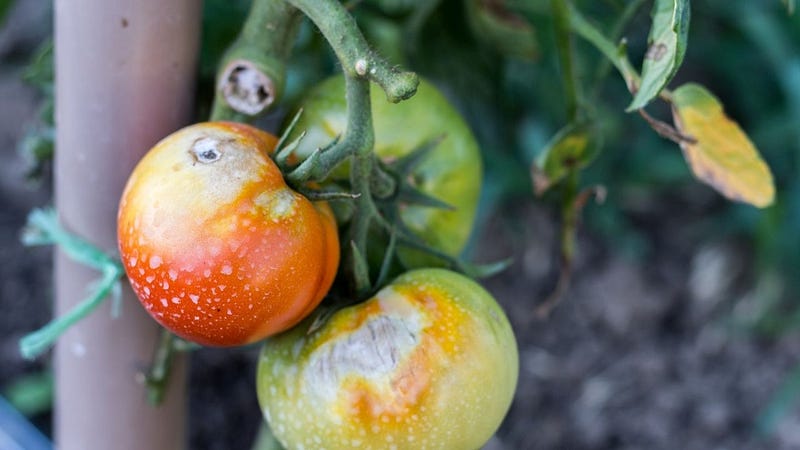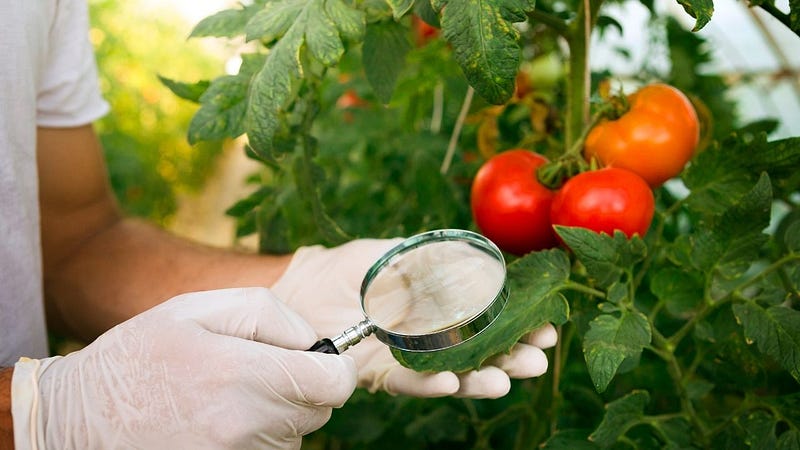
Numerous farmers like cultivating tomato plants that may flourish with little care if planted in areas with lots of sunlight and water.
On the other hand, Tomatoes are prone to a variety of issues that can leave their owners in a state of distress. It’s amazing how many individuals still grow these, given how difficult they are.
Tomato Plant Leaves Turning Yellow can be caused due to different factors. Yellow tomato leaves, though on the other hand, do not always indicate that the plant is in trouble. Pest infestations, illness, or severe warmth may impair the health of tomato leaves causing their discoloration to yellow. These factors also affect the plant’s stalks or fruits which causes the lowering overall production of tomatoes.
Top 15 Causes Of tomato plant leaves turning yellow
Several factors can make tomato plant leaves become yellow, the majority of which are simple to fix. Yellow leaves on tomatoes could also be caused by nitrogen deficits in the ground, underwatering, excess watering, or a lack of sunshine on the underside leaves.
Tomato Plant Leaves Turning Yellow
The most prevalent reasons for yellowing tomato leaves are listed here, along with what you could do about it.
1) Early Blight
Annually in a yard, early blight is the root cause of tomato leaves turning yellow, and it’s simple to notice if you specifically check for it. Early blight is triggered by a soil-borne fungal that spreads from the ground to the leaf margins.
These bottom, older leaves will develop oddly shaped yellow splodges that grow to brown patches with a yellow “dome” surrounding them in the early stages of the disease. The splodges have a brown core, almost like a bullseye.
As the illness spreads untreated, the whole branch and bottom tomato leaves turn yellow, eventually brown, before eventually shriveling up.
2) Septoria Leaf Spot
Septoria leaf spot, a whole other fungal infection, is similar to early blight in many aspects. Marks on the bottom, older leaves start yellow, soon develop into brown, ultimately tan or gray, similar to early blight.
Such dots are relatively small and far more frequent unlike initial blight spots because they have a more circular shape. The dots will combine into a bigger brown region as the illness advances and the patches expand in size.
Water-soaked sores, almost always on the underneath of the leaf also do occur. A secondary disease can emerge in the core, with small black pimple-like patches ( tomato plant yellow leaves brown spots) that infect the remainder of the crop. The leaves will become yellow, brownish, and eventually die if left untreated.
3) Verticillium Wilt
Verticillium wilt causes yellowish and brownish spots on leaves that run from the center vein to the margin, frequently in a V-shape. Throughout the heat of the day, crops wilt. Verticillium wilt progresses slowly and uniformly across the plant, however, there is no treatment, and it will finally kill the plant.
Remove the stalk at the soil’s surface if you detect verticillium wilt, then if you discover brown in the typically white plant tissues, the disease has gotten out of control.
4) Fusarium Wilt
Fusarium wilt does not usually develop until the plant’s fruit has reached maturity. Bottom tomato leaves turning yellow and occasionally only one branch or shoot is affected, which is vibrant yellow and withering. The withering will first improve after night.
Although the plant’s development is slowed, if the development is restricted to one branch, many of the crops might mature even before the plant dies. Cutting the branch for fusarium wilt will show the brownish vascular structure and verticillium-like wilt, and there is no treatment.
5) Tomato mosaic virus
The tomato mosaic virus is often a dangerous and infectious illness. It’s also difficult to see, with indications that vary greatly relying on the species and maturity of the diseased plant, virus strain, and environmental factors.
Fruit development may be severely reduced on diseased plants but those that did develop may be spotted with yellow spots and necrotic patches, with a brownish core. Infected stems, sepals, leaves, and seeds may all display symptoms.
6) Tomato Yellow Leaf Curl
Tomato plants yellowing leaf curl is an infection transmitted by the Tomato Yellow Leaf Curl Virus that affects tomatoes. Infectious plants’ leaves are tiny and curled up into the air, with mottling and border yellowing and pronounced crumpling.
Diseased plants’ internodes shrink, and their development is impeded, giving them a bushy look that is frequently alluded to as ‘orchids’ or broccoli-like development.
Initially in the blooming period aphids are common on tomato crops. Tomato leaves may yellow and fade as a result of their eating, but the impact is typically not serious except your crops are already affected by dryness or illness.
8) Psyllids
Psyllids ( Bactericera cockerelli) prey on tomato crops releasing poison into the leaves which produces psyllid yellow discoloration. The veins of the leaves turn purple, while the branches grow twisted.
Psyllid nymphs are roughly the dimension of an aphid and can be discovered on the lower part of leaves. They are yellow at first before turning emerald. Psyllids release sugar-like particles while they munch on your plant.
9) Whiteflies
Tomato pests include greenhouse whitefly (Trialeurodes vaporariorum), Silverleaf whitefly (Bemisia argentifolii), and Bandedwinged whitefly (Trialeurodes abutilons).
The most dangerous whiteflies towards your tomato crop are Silverleaf and garden whiteflies, however, numerous kinds can be discovered on the leaves of your tomato crop.
Leaves might yellow and twist as a result of whitefly eating. Fruit that has been fed by Silverleaf whitefly ripens abnormally. Adults are little yellowish bugs with fluffy feathers which can be seen through amplification and are spotted on the lower part of your plant’s leaves.
10) Flea Beetle
Small brown or black insects that leap when startled are known as flea beetles. It is a typical seedling tomato bug that causes microscopic perforations in the plant as well as fading of the foliage.
While immature tomato plants can withstand a flea beetle assault, dry, gusty weather might add significant stress to induce plant demise.
Flea Beetle also causes yellow tomato plants.
The presence of yellow-brown leaves on tomato plants might signal that the plant isn’t getting enough sunshine. Even when the plant is in direct sunshine, the lower leaves could be getting insufficient light while becoming yellow.
11) Lack Of Sunlight
A few of the lower leaves eventually become yellow and fade, allowing the remainder of the plant and the budding tomatoes to get enough sunshine to mature.
Aphids on the other hand may spread viruses, while the dew they produce draws ants and can lead to sooty mold diseases.
When tomato crops are regularly replanted in just the same ground, the soil turns barren well as the pH level rises. Yellow leaves on tomato plants as well as no tomato output will occur if the tired soil turns excessively acidic.
13) Lack Of Nitrogen
The mature plant leaves usually start to turn light yellow when the soil is deficient in nitrogen. Your plant’s upper leaves would stay green, however after the leaves appear yellow, this same plant will cease developing and yielding.
14) Under-watering
The leaves of a parched tomato crop usually shrivel first then eventually turn yellow. The plant’s first sign of dehydration is wilting. The wilting of the leaves indicate that it is in desperate want of watering.
The leaves margin will change into a golden tone initially. It will then proceed until the whole leaf has become yellow and has fallen off the plant.
15) Over-watering
Overwatering makes the soil wet and makes it difficult for oxygen to circulate through it. Given the lack of air, the leaves become yellow, as well as the plant progressively drowns.
Tips For Fixing Tomatoes Yellow Leaves

1. Make Use Of A Fungicide.
Although a fungicide won’t help your tomato plants if they’re suffering from viral infections. Fungicide would help them if they’re suffering from fungal infections like fusarium wilt. To get the greatest results, use a fungicide that contains chlorothalonil.
2. Get Rid of Your Pest Challenges
Pesticidal soap or gardening oil can be used to manage these bugs. Cutworms and hornworms, for example, are simple to handle by plucking them off from the crop by hand.
3. Keep An Eye On The Watering
Based on the temperature and growing conditions, hydrate thoroughly each five to seven days, however, allow it to dry out amid waterings.
Read the complete and original article on Tomato plant disease, pests, and care.




























